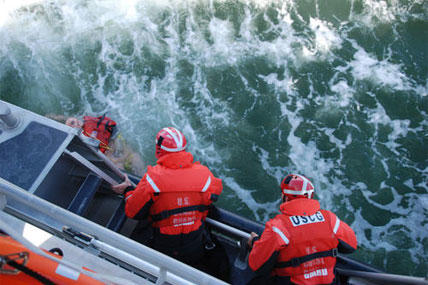ILWACO, Wash. — The Columbia River entrance, located on the Pacific Coast on the border of Oregon and Washington State, is widely known as one of the most dangerous river bars in the world. The area is often referred to as “The Graveyard of the Pacific” due to all the shipwrecks and lives lost there. Strategically situated near the river’s entrance in Ilwaco are the U.S. Coast Guard National Motor Lifeboat School and Station Cape Disappointment. Aiming to save more lives and better train boat operators and crewmembers, the units recently joined forces to conduct a two-week seamanship course that ended Thursday, August 30, 2012.
The two units, separate but located next to one another, seized an exciting opportunity to work together in creating the seamanship course. With an abundance of new members (break-ins) arriving to the units, the outcome of the course was break-ins learning and becoming qualified on the 47-foot motor lifeboat more efficiently.
"It’s normally a four-month process to get qualified on a 47-foot motor lifeboat, but it only took the break-ins two weeks,” said Chief Petty Officer Jeremiah Wolf, Surfman trainer at Station Cape Disappointment. “We had ten break-ins from the station go through the course and six of them completed their performance qualification standards. Now all six are ready for check rides, the final test on the boats to see if they are able to execute what they have been taught; to perform effectively in a real life setting. This course was very helpful in improving training and a great opportunity to work with the NMLBS. It took a joint effort of sharing boats and collaborating with instructors to get the course going.”
Since the course was a success, both the station and NMLBS plan to teach the course again next year when the new transfer season comes up, and the two units receive another plethora of new personnel.
“We had a lot of new personnel who arrived at the NMLBS two-weeks prior to the course’s introduction and we were able to get them a lot of boat time,” added Petty Officer 1st Class Clifford Hopson, lead training officer at NMLBS. “ The course was found to be a less stressful way for the new break-ins to learn because of how it was structured. They were able to sit in class first for training, then were taught out on the boats. Usually they would have to learn everything on their own time or set up times with instructors to be given the training they would need to be qualified on the 47-foot motor lifeboat.”
The seamanship course consisted of the break-ins learning the specifications of the 47-foot motor lifeboat and practicing approximately two hours of anchoring, four hours of man overboard and boat handling drills, and six hours of towing. The break-ins also learned how to tie knots, work with lines and spent a day learning radar/GPS.
“The course was very informative and great because it helped me catch up on the sign-offs I was lacking and went more in depth on the things I have already learned,” remarked Seaman James Bello at Cape Disappointment. “I am much closer to being boat crew qualified thanks to this course.”
Many Coast Guard members from across the country get sent to the NMLBS, the only training center that instructs Coast Guard personnel how to maneuver the 47-foot motor lifeboat in basic weather and rough surf conditions.
Cape Disappointment is known as the largest Coast Guard search and rescue station on the Northwest Coast working at one of the most treacherous river bars in the world. The station responds to approximately 300-400 calls for help every year.
“The partnership between the two units has existed since the National Motor Lifeboat School's birth when Surfman gathered to conduct training at Station Cape Disappointment,” stated Lt. Scott McGrew, Commanding Officer of Station Cape Disappointment. “Between our Surfman and their instructor staff, that's hundreds of years experience teaching basic boat crewmen. You won't find that type of training anywhere else in the Coast Guard. We are fortunate to have the NMLBS next door and the recent joint effort boat crewman course went a long way to creating a few more professionals.”

























